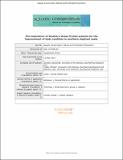The importance of Southern Ocean frontal systems for the improvement of body condition in southern elephant seals
Abstract
1. As top predators, it has been suggested that southern elephant seals serve as sentinels of ecosystem status to inform management and conservation.2. This is because southern elephant seals annually undertake two large‐scale foraging migrations for 2–3 and 7–8 months to replenish resources after fasting during breeding and moulting and often rely on dynamic macroscale latitudinal fronts to provide favourable foraging through aggregating prey.3. Yet it is largely unknown whether southern elephant seals respond to changes in frontal systems over the years, whether their foraging success is associated with specific frontal systems shifts, and how flexible southern elephant seals populations are in behaviourally adapting to changes in frontal systems.4. This study examines the relationship between frontal systems and the resource acquisition of 64 southern elephant seals during four post‐moult and three post‐breeding migrations between 2005 and 2010.5. Satellite‐relay‐data‐loggers provided in situ measurements concurrent with >27,500 dive profiles to define fronts and interfrontal zones between the Subtropical Frontal Zone and the Southern Boundary of the Antarctic Circumpolar Current. For >430,000 in situ measurements water mass properties could be identified.6. Generally, southern elephant seals associate more frequently with more southerly, higher‐latitude fronts/zones. Body condition improvements related to a given frontal system or water mass vary strongly according to year, season, month and sex.7. The variability in body condition improvements is higher in some frontal systems than in others, probably owing to shifts in the Subantarctic and Polar Front.8. During a migration, some individuals stay within ≤3 frontal systems, whilst others change between several frontal systems and primarily improve their body condition in upper ocean waters.9. Southern elephant seals do not trace particular water masses across frontal systems, and both surface and deep foraging strategies are used.10. This suggests that southern elephant seals do not target particular water masses but adjust foraging and movement strategies to exploit boundary areas at which mixing and prey aggregation is high.11. The large behavioural plasticity towards the spatio‐temporal variability in the different oceanographic regions they encounter could indicate resilience against environmental changes.
Citation
Gordine , S A , Fedak , M A & Boehme , L 2019 , ' The importance of Southern Ocean frontal systems for the improvement of body condition in southern elephant seals ' , Aquatic Conservation: Marine and Freshwater Ecosystems , vol. 29 , no. S1 , pp. 283-304 . https://doi.org/10.1002/aqc.3183
Publication
Aquatic Conservation: Marine and Freshwater Ecosystems
Status
Peer reviewed
ISSN
1052-7613Type
Journal article
Description
Funding: Natural Environment Research Council, Grant/Award Numbers: NE/E018289/1, NE/L501852/1 NER/D/S/2002/00426; Scottish Funding Council, Grant/Award Number: HR09011.Collections
Items in the St Andrews Research Repository are protected by copyright, with all rights reserved, unless otherwise indicated.

